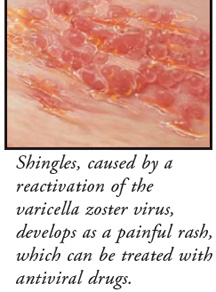 Painful Rash Caused by the Chickenpox Virus
Painful Rash Caused by the Chickenpox Virus
Shingles is a painful condition that affects older adults who have previously suffered from chickenpox at some point in their lives. It is caused by a reactivation of the varicella zoster virus that lies dormant (not active) in the body’s nerve cells. For reasons that scientists do not fully understand, varicella zoster can become reactivated many years after an infection with chickenpox and travel along the nerve paths to the skin’s surface. The virus causes a painful rash that eventually turns into tiny blisters, which break open and crust over. Antiviral drugs can be used to reduce the severity of symptoms and shorten the attack, but they are effective only if they are used within 72 hours of the appearance of the rash.
For most shingles sufferers, the entire shingles outbreak lasts four or five weeks. But for almost one third of patients age 60 years or older who develop shingles, the pain lingers for months, even years. This chronic painful condition is known as postherpetic neuralgia. Postherpetic neuralgia is difficult to treat, and the long-standing pain can cause patients to become depressed and unable to care for themselves.
There is hope, however, for the millions of older people who have not yet suffered from shingles. A shingles vaccine has been developed and is awaiting approval by the FDA. In clinical studies, this vaccine prevented shingles in about half of the patients who received it, and those who did contract the disease had a milder case than they would have had otherwise.
Condition Common in Older People
Shingles is a problem for over one million people each year, half of whom are over age 60. Incidence increases with age: Of all people who live to age 85, half will develop this condition.
The greatest risk factor is a previous bout with chickenpox, since a person must have a history of chickenpox to develop shingles. Older people have the greatest risk, which may be related to a weaker immune system that comes with aging. Shingles will develop in one of every five persons over age 50 who had chickenpox before. It is also more likely to occur in people with weakened immune systems due to other causes, such as cancer, organ transplant, HIV/AIDS, or use of drugs that suppress the immune system, including steroids or chemotherapy.
Regularity of Symptoms: Symptoms follow a fairly regular pattern, beginning with a tingling, numbness, or burning sensation under the skin. Shingles often causes generalized feelings of illness, like fever and chills, nausea, or a headache. After a few days, a rash appears in the pattern of a band, often on one side of the body, face, or neck. The rash begins as small, itchy bumps, which eventually fill with fluid, break open, and crust over into scabs. The area usually heals without scarring unless it becomes infected.
Early Diagnosis: Rapid diagnosis of shingles is very important, since antiviral medications do not work if given more than 72 hours after the rash appears. Although diagnosis is usually made by inspecting the rash and its pattern, laboratory testing can confirm the diagnosis. Once shingles is diagnosed, it is important for the patient to avoid people who have never had chickenpox, since exposure to shingles can cause chickenpox in these people. However, exposure to shingles will not cause someone else to “catch” shingles, because shingles only comes from a reactivation of virus that has become dormant after a bout with chickenpox.
To Relieve Symptoms: If treatment is begun within 72 hours of the appearance of a shingles rash, such antiviral medications as acyclovir, famciclovir, or valacyclovir can significantly reduce the severity of symptoms and shorten the attack. Antiviral medications given soon after the rash appears may also help prevent the development of postherpetic neuralgia— a painful complication of shingles that is not easily treated.
Other treatments for shingles can help relieve pain and itching. Cool soaks or oatmeal baths may be recommended to help speed the drying and healing of blisters. For pain control, analgesics (painkillers), steroids, antidepressants, and anticonvulsant medicines are options.
Potential Complications: Most people who suffer from shingles completely recover in four or five weeks. However, complications can arise in some people that can be serious consequences of varicella zoster reactivation. The rash may become infected with constant scratching, and antibiotics may be required to treat it. If the shingles rash is located near the eyes or ears, damage to sight or loss of hearing can result. Another serious complication of shingles is postherpetic neuralgia, a sharp or throbbing pain under the skin that remains after the rash of shingles has healed. Postherpetic neuralgia can cause pain so severe that it hurts to have clothes touching the skin. The older the patient is when shingles develops, the greater the chance for postherpetic neuralgia to develop. This nerve pain can last for months or even years, making routine activities difficult and resulting in serious depression.
A New Preventive Measure: A vaccine similar to the chickenpox vaccine will soon be available for older patients at risk of developing shingles. Millions of people may never suffer the pain of shingles or may have only mild symptoms. As our population ages, this vaccine will be a powerful weapon against shingles and its possible debilitative effects.











